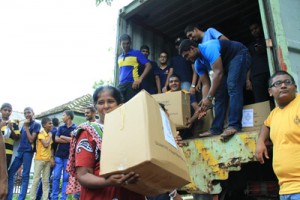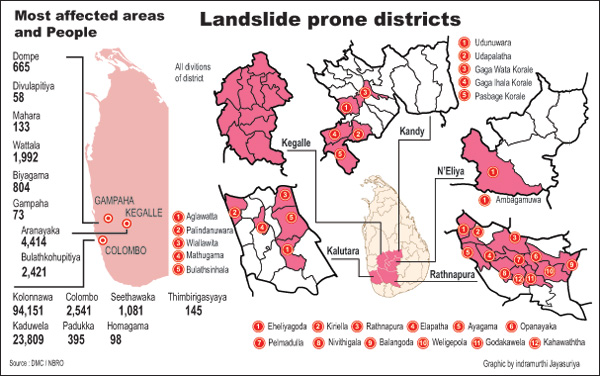News
Solutions under our nose for better crisis co-ordination
For the past few years, Sri Lankans have been receiving text messages on their mobile phones from their President, wishing them a happy New Year in all three languages. The messages have irritated some, who see it as an invasion of privacy. These messages, though, make it clear that a mechanism exists whereby text messages can be sent to large segments of the population.
So questions have been raised about why such technology was not utilised to warn people when adverse weather caused havoc the previous week.

Groups sprang up on Facebook while people also took to platforms such as Twitter, Whatsapp and Viber to organise themselves into volunteer groups. Pic by Indika Handuwala
Warnings regarding rising floodwaters were not properly communicated and relief efforts were also hampered due to the lack of central coordination. It was during this time that groups of citizens decided to harness the power of social media to mobilise. Groups sprang up on Facebook while people also took to platforms such as Twitter, Whatsapp and Viber to organise themselves into volunteer groups.
Amalini De Sayrah, who had worked with a group called One World Volunteers, told The Sunday Times social media was largely involved in helping people organise donation drives. She had worked at two collection points.
“I remember gathering a lot of information via Twitter and then saw a few posts from a friend on Facebook, asking for items. When I asked how I could help, he added me onto both groups that were functioning to collect aid supplies,” she explained. Her group had worked in several areas around Colombo and outstations, including Elakanda, Chilaw, Kerawalapitiya and Slave Island. They had also organised to send some aid to Kilinochchi.
She said that while there was some level of coordination between volunteers and local authorities, when it came to aid distribution there was no central coordination. “Citizens were sending what they could, and they meant well, but without one agency sorting through all the information and saying ‘Supplies X, Y, Z go to Town A’, there was a mess. Some places got far more than they needed and other places, really small villages off the radar where there was no contact from the ground, didn’t get anything at all,” Ms De Sayrah said.
Aisha Nazim was another who answered a call for volunteers posted on Facebook. She said the people she worked with had come from everywhere; most of them she had never met before. “They were highly organised, some had contacts with the navy, and are now working with the Government Medical Officers’ Association (GMOA) to set up med camps this weekend.”
She said the volunteer group had on-the-ground contacts and knew of people in pockets of Kelanimulla and Kerawalapitiya who had reportedly been completely missed by both the authorities and other aid groups. These were the people they tried to reach.
“The ones in Kerawalapitiya said that they receive cooked food from the navy and churches so immediate food needs are sorted. They don’t, however, have clothes,” she said, underlining the problems that arise from a lack of central coordination of relief operations.
There are allegations that the authorities could have utilised locally-available systems that could have helped to better coordinate disaster relief efforts. One such innovation is Sahana software. In the immediate aftermath of the Indian Ocean tsunami of 2004, a group of software engineers from Sri Lanka came together to work out ways to be better prepared for future disasters. Their efforts, with funding from the Lanka Software Foundation (LSF), led to the setting up of Sahana software, designed to aid rescue and relief efforts during disasters.
In the years since its inception, Sahana software has been used in countries such as the Philippines, Pakistan, Japan, Haiti and the United States for relief efforts during natural disasters.
According to Founding Chair of LIRNEasia and former chairman of LSF, Professor Rohan Samarajiva, the software had been offered to the international community while he was chairman of the board, and this had resulted in the establishment of the Sahana Foundation. He pointed out that, at the time, the software was even being used by authorities in New York for disaster relief purposes, “but we couldn’t get it accepted and implemented here,” he said.
Simply put, the Sahana software is a set of interconnected databases that can be incorporated into a system to manage disaster relief efforts. For example, one database can list supplies that are necessary, such as food, medicines and so on. Another database would have information on what is needed and where.
The two databases can then be matched to see which supplies are needed where. Another database can have lists of missing persons which can then be compared to another database listing people who have been rescued or have made it to safety.
Prof. Samarajiva said if the system was managed by the government, resources could have been utilised so that, for example, when food has been delivered to a particular area by volunteer groups a call could be given to a central authority to say food has been delivered to this area and then the database would reflect that.
He also said they had also provided funding for an SMS model so that personnel in the field authorised to communicate with the central entity could upload the data accordingly. “Sadly, these things were not done,” he said. He acknowledged that the system was complicated. “But it’s not rocket science,” he quipped, and stated people would be able to use the system effectively if given adequate training.
Sri Lanka’s disaster management was a very short-term exercise, Sahana Software Foundation Director Nuwan Wadyanatha observed. “There’s the initial crisis window (one week); after two weeks it’s all forgotten, victims are taken care of by NGOs and the community; no pressure for the government.
“Moreover, such large-scale crises are infrequent. If one were, however, to add up the economic losses of small-scale events, over a long period they [accumulate] to about the same as the one-off large ones,” he said in an email.
If policy-makers were to realise that large-scale crisis management is simply a scale-up of small-scale emergency management, and if systems are implemented for managing day-to-day emergencies, then those same systems that are integrated into daily practices could be used to manage the one-off crises, Mr. Wadyanatha pointed out, noting that Sahana software could have helped to manage the current crisis.
The Assistant Director of the Disaster Management Centre (DMC), Pradeep Kodippili said the centre upgraded its systems annually but was now looking to further enhance its networks for better coordination.
He said under the current system, warnings are disseminated by the DMC based on reports sent by various agencies such as the Irrigation Department and the Department of Meteorology. Messages are then sent out by the DMC to media organisations which, in turn, relay them to the public.
He however, admitted that more work had to be done. “We have currently finished testing an automated warning system that would send calls to fixed landlines in people’s homes. In the event of an impending natural disaster, we will soon be able to alert people using this method,” he said.
The Secretary to the Ministry of Disaster Management, S.S. Miyanwala said he could not rule out the fact that aid might have reached some areas slower than others but claimed such shortcomings were unavoidable during a disaster of this magnitude.
“We saw people organising among themselves and taking aid independently to affected areas. They were only trying to help. But this may have caused an excess of aid supplies to certain areas. But whenever we were notified of shortcomings, we always took measures to send relief to such locations,” he said.


